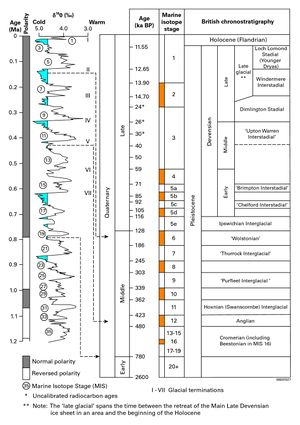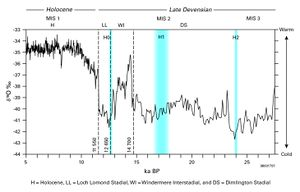Record of climate change, Northern England: Difference between revisions
BobMcIntosh (talk | contribs) No edit summary |
m (Text replace - "From: Stone, P, Millward, D, Young, B, Merritt, J W, Clarke, S M, McCormac, M and Lawrence, D J D. 2010. British regional geology: Northern England. Fifth edition. Keyworth, Nottingham: Britis) |
||
| (One intermediate revision by the same user not shown) | |||
| Line 1: | Line 1: | ||
''' | '''{{NERG}}''' | ||
Latest revision as of 12:32, 6 May 2016
| From: Stone, P, Millward, D, Young, B, Merritt, J W, Clarke, S M, McCormac, M and Lawrence, D J D. 2010. British regional geology: Northern England. Fifth edition. Keyworth, Nottingham: British Geological Survey. |
Introduction


Evidence of global Quaternary environmental change has been found in deep-sea sediments, in cores of ice taken from the summits of the Greenland and Antarctic ice sheets and from extended sequences of interbedded loess and organic deposits from continental Europe and Asia. The onset of glaciation in the Northern Hemisphere probably began in the Late Miocene, suggesting that the climate of the British Isles had begun to deteriorate long before the beginning of the Quaternary Period at 2.6 Ma, when ice-rafted debris first appears in the North Atlantic deep ocean record.
The frequency, rapidity and intensity of climatic change are key features of the Quaternary, with climate alternating between ‘glacial’ and ‘interglacial’ modes; at least 50 significant ‘cold–warm’ oscillations have been recognised. The driving force of climatic change is the long-term cyclical variation in the incidence of solar energy caused by the Earth’s orbital periodicities, which run over roughly 23 ka, 41 ka and 100 ka intervals. These fluctuations have been amplified substantially by additional factors involving physical, biological and chemical interactions together with ‘feedback loops’ between the atmosphere, oceans and ice sheets. Of particular importance to the British Isles are changes in the position of the Gulf Stream. This northward-flowing current of warm surface water is compensated by the return southwards of cold, dense water at depth. Sudden changes in this circulation pattern had a major impact on climate.
An invaluable proxy record of global climate is provided by the relative proportions of the two common isotopes of oxygen contained in the skeletons of calcareous microfossils recovered from deep ocean sediment cores. During glacial periods the oceans’ water becomes relatively enriched in the heavy isotope of oxygen (18O), and the marine (oxygen) isotope stages (MIS) thus obtained now provide a universal means of dividing the Quaternary (P916094). The oxygen isotope record indicates that during the Early Quaternary, when glaciers possibly first developed in the Cumbrian Mountains, each of the principal cold–warm cycles lasted about 40 ka. Following a major change at about 780 ka BP, there have been seven longer, more rigorous glacial–interglacial cycles, although substantial ice sheets appear to have grown in only three or four of them in the Northern Hemisphere. Each of these glacial episodes lasted between 80 and 120 ka and was followed abruptly by an interglacial lasting 10–15 ka; the rapid deglaciations are described as ‘terminations’ (P916094). The glacial periods included long, cold intervals, termed ‘stadials’, and less cold, or even warm, ‘interstadials’ lasting for a few thousand years. Most terrestrial evidence preserved in northern England relates to the last major glacial–interglacial cycle (Devensian and Holocene stages), but older deposits are preserved locally.
High-resolution evidence from Greenland ice cores, coupled with the MIS record, confirms that dramatic climatic changes have occurred on the millennial (and possibly even decadal) scale. Some 24 interstadial intervals are now identified in the Devensian stage alone, compared with the five or six that were recognised previously from the pollen record and formalised in the traditional British chronostratigraphy (P916094). These short interstadials started with abrupt warming and typically cooled over a period of 1 to 3 ka, several being grouped together and superimposed on longer cycles during which temperatures declined gradually (P916095). The culmination of each overall cooling phase was a glacial readvance of regional extent coinciding with a massive discharge of icebergs into the North Atlantic (known as a ‘Heinrich event’), as indicated by the appearance of abundant ice-rafted debris in deep ocean sediment cores.
Bibliography
Boardman, J (editor). 1981. Field Guide to Eastern Cumbria. (Brighton: Quaternary Research Association.)
Boardman, J, and Walden, J (editors). 1994. The Quaternary of Cumbria: Field Guide. (Oxford: Quaternary Research Association.)
Bowen, D Q (editor). 1999. A revised correlation of the Quaternary deposits in the British Isles. Geological Society of London Special Report, No. 23.
Bridgland, D R, Horton, B P, and Innes, J B. 1999. The Quaternary of north-east England: Field Guide. (London: Quaternary Research Association.)
Chiverrell, R C, Plater, A J, and Thomas, G S P. 2004. The Quaternary of the Isle of Man and North West England: Field Guide. (London: Quaternary Research Association.)
Ehlers, J, Gibbard, P L, and Rose, J (editors). 1991. Glacial deposits in Great Britain and Ireland. (Rotterdam: Balkema.)
Huddart, D, and Glasser, N F. 2002. Quaternary of Northern England. Geological Conservation Review Series, No. 25. (Peterborough: Joint Nature Conservation Committee.)
Hughes, D P, Mauquoy, D, Barber, K E, and Langdon, P. 2000. Mire-development pathways and palaeoclimatic records from a full Holocene peat archive at Walton Moss, Cumbria, England. The Holocene, Vol. 10, 465–479.
Lambeck, K, and Purcell, A P. 2001. Sea-level change in the Irish Sea since the Last Glacial Maximum: constraints from isostatic modelling. Journal of Quaternary Science, Vol. 16, 497–506.
McMillan, A A, Hamblin, R J O, and Merritt, J W. 2004. An overview of the lithostratigraphical framework for Quaternary and Neogene deposits of Great Britain (Onshore). British Geological Survey Research Report, RR/04/04.
Merritt, J W, and Auton, C A. 2000. An outline of the lithostratigraphy and depositional history of Quaternary deposits in the Sellafield district, west Cumbria. Proceedings of the Yorkshire Geological Society, Vol. 53, 129–154.
Shennan, I, and Andrews, J. (editors). 2000. Holocene land–ocean interaction and environmental change around the North Sea. Geological Society of London Special Publication, No. 166.
Zong, Y, and Tooley, M J. 1996. Holocene sea-level changes and crustal movements in Morecambe Bay, northwest England. Journal of Quaternary Science, Vol. 11, 43–58.